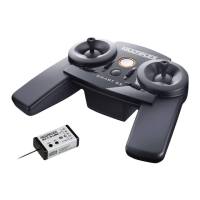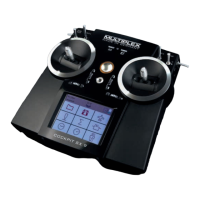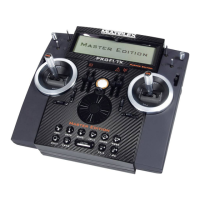ROYAL SX
76
Coll.(pitch)+, Coll.(pitch)-, Offset, Zero point
Notes:
It is important to complete all the rotor head settings
(including collective pitch curve) before you set up the
mixer TAIL. The throttle curve must also be adjusted
carefully before you attempt to carry out fine-tuning
with the model in the air. If you subsequently change
the throttle curve, you will normally have to correct the
settings in the TAIL mixer.
If you are using a heading-lock gyro in heading mode,
the TAIL mixer must not be used, and should be
switched off permanently.
Preparation:
You must assign TAIL in the menu ¤Servo.Assign,
otherwise the mixer TAIL will not appear in the
menu £Mixer.
A two-point calibration is sufficient when setting up
TAIL. Important: take care that the servo is not
stalled (mechanically obstructed) at its end-points
(P1, P5).
a. Basic Offset value
To compensate for the torque at 0° collective pitch
(main rotor), a small tail rotor pitch angle (= Offset)
is required; the value can be set separately in each
flight phase. This will be necessary if you set different
system rotational speeds in the various flight phases.
In the flight phase AUTOROT (Auto-rotation) the Off-
set can be changed so that no tail rotor pitch is pre-
sent at all. This is particularly important if your model
helicopter features a driven tail rotor.
b. Collective pitch to tail (Revo-Mix)
The Collective pitch tail rotor mixers are set using
the parameters Coll.+ / Coll.-, separately for climb
and descent, and for each flight phase:
Coll.+ correction for climb
Coll.- correction for descent
The exact values can only be established through a
programme of flight testing, as they vary according to
many parameters.
c. Mixer Zero point
The Zero point is where you set the starting point for
the static tail rotor compensation mixer. The collective
pitch tail rotor mixer takes effect from this collective
pitch angle in the direction of “climb”, using the value
set under Coll.+. In the other direction (descent) the
value set under Coll.- takes effect.
Procedure:
Move the collective pitch stick to the position equating
to 0° collective (use a rotor blade gauge if available).
Note: you should first set up the collective pitch curve
completely.
The Collective pitch value (Collect. / last line) can-
not be changed, as it simply shows the current posi-
tion of the collective pitch stick, and serves as an aid
when setting-up. This value is set in the Zero point
parameter.
d. Differential yaw (rudder) travel
The purpose of the Yaw (rudder) differential para-
meter (Rudd.Diff.) is to reduce the tail rotor travel in
one direction. This is necessary if the model behaves
differently when yawing (yaw commands) to left and
right (angular velocity). Since the tail rotor has to
counteract the torque generated by the main rotor,
“Yaw” is usually weaker when the model is required to
turn against the direction of the main rotor.
A separate value can be set for each flight phase.
16.2.4. Rotor head (swashplate mixer)
The ROYAL SX features a universal swashplate mixer
(CCPM) which can be used to control all types of
swashplate fitted with three or four linkage points /
servos.
Three parameters are required to set up the mixer.
Geometry, Rotation, Lever +/-:
Note:
The main menu Mixer is a dynamic menu, i.e. it only
displays those mixers which are used for the current
model. The mixer Rotor head only appears if you
have selected the model template HELIccpm.
To ensure that the swashplate moves in the required
manner, the swashplate servos must be connected to
the receiver in the correct sequence. The channel as-
signment varies according to the selected servo con-
figuration and can be viewed at any time in the menu
Servo, Assignment ( 17.2.):
Front or back swashplate servo
Left swashplate servo
(as seen from the tail)
Right swashplate servo
(as seen from the tail)
Parameter: Geometry
90 ... 150 / -90 ... -150
Default 120
The parameter Geometry describes the angle between
the swashplate servo HEAD f/b and the two symmet-
rically positioned servos HEAD le and HEAD ri.

